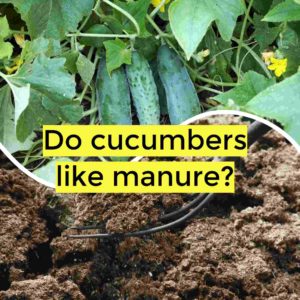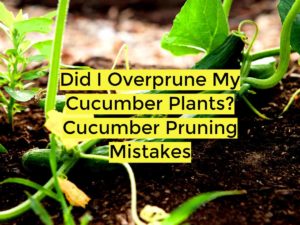Cucumbers look good in the garden and table, with their lush green vines and refreshing fruits perfect for salads and snacking. However, as a cucumber plant owner, you may encounter issues with the leaves turning brown and becoming brittle, leaving you wondering what could be causing this problem. In this in-depth article, we will explore the potential reasons behind cucumber leaves turning brown and brittle, how to address this issue, and whether it is necessary to remove the affected leaves. Additionally, we will touch upon the related problem of cucumber leaves turning yellow and crispy.
Why Are Cucumber Leaves Turning Brown and Brittle?
Several factors can contribute to cucumber leaves turning brown and brittle, and it is essential to identify the root cause to effectively address the issue. Here are some common reasons:
Fungal Diseases
Cucumber plants are susceptible to various fungal diseases, such as powdery mildew, downy mildew, and anthracnose. These diseases can cause browning and brittleness of the leaves. Fungi thrive in warm and humid conditions, making cucumber plants in such environments more prone to infection.
Watering Issues
Inconsistent cucumber watering practices, such as alternating between overwatering and underwatering, can stress the cucumber plant. Overwatering can lead to root rot and poor nutrient uptake, while underwatering can result in dehydration and nutrient deficiencies, both of which can cause browning and brittleness in the leaves.
Nutrient Imbalance
Cucumber plants require a balanced mix of essential nutrients for healthy growth. A deficiency or excess of certain nutrients, particularly nitrogen, potassium, and magnesium, can lead to leaf discoloration and brittleness.
Pest Infestations
Insects like spider mites, aphids, and cucumber beetles can attack cucumber plants and damage the leaves. Their feeding habits can cause browning and make the leaves brittle over time.
Environmental Stress
Extreme temperatures, excessive sunlight exposure, or sudden changes in weather conditions can stress cucumber plants, leading to leaf browning and brittleness.
What to Do When Cucumber Leaves Turn Brown?
When you notice your cucumber leaves turning brown, taking prompt action can help salvage your plant’s health and productivity:
Inspect for Pests and Diseases
Examine the affected leaves closely for any signs of pests or fungal diseases. If you spot pests, use organic insecticidal soap or neem oil to control the infestation. For fungal diseases, consider applying copper-based fungicides or neem oil, ensuring thorough coverage on both sides of the leaves.
Improve Watering Patterns
Maintain a consistent watering schedule and ensure that the soil remains evenly moist. Avoid overwatering, which can lead to root rot and fungal issues, as well as underwatering, which can stress the plant. Water at the base of the plant, avoiding wetting the leaves, as excess moisture on the foliage can promote fungal growth.
Address Nutrient Imbalance
Conduct a soil test to determine if there are any nutrient deficiencies or imbalances. If necessary, apply a balanced fertilizer or organic compost to provide the plant with the nutrients it needs.
Provide Shade and Shelter
If your cucumber plants are exposed to intense sunlight, consider providing some shade during the hottest parts of the day to reduce stress on the leaves. Additionally, consider using row covers or other protective measures to shield the plants from extreme weather conditions.
Prune Affected Leaves
If the browning and brittleness are limited to a few leaves, carefully prune them using clean, sharp scissors or pruning shears. Removing affected leaves can prevent the spread of diseases and redirect the plant’s energy to healthier parts.
Should I Remove Brown Leaves from Cucumber Plant?
When cucumber leaves turn brown, the question of whether to remove them often arises. In general, it is a good idea to remove severely damaged or infected leaves from the cucumber plant. Doing so can prevent the spread of diseases and pests to other parts of the plant. Additionally, removing damaged leaves allows the plant to focus its resources on new growth and fruit development.
When pruning, make sure to use clean and sharp tools to minimize the risk of spreading diseases. Disinfecting your pruning tools between cuts with a solution of one part bleach to nine parts water can help prevent cross-contamination.
Why Are My Cucumber Leaves Turning Yellow and Crispy?
Yellowing and crispiness in cucumber leaves can also be indicators of underlying issues:
1. Water Stress: Underwatering or overwatering can cause the leaves to turn yellow and become crispy. Inadequate water supply deprives the plant of essential nutrients while overwatering can lead to root suffocation and nutrient deficiencies.
2. Heat Stress: Cucumber plants are sensitive to extreme heat. High temperatures can cause the leaves to lose water rapidly, resulting in yellowing and crispiness.
3. Nutrient Deficiencies: Lack of essential nutrients, such as nitrogen, iron, or magnesium, can cause yellowing in cucumber leaves. Soil tests can help identify and rectify nutrient deficiencies.
4. Pest Infestations: Pests like spider mites and aphids can cause yellowing and wilting of cucumber leaves by sucking sap from the plant.
Conclusion
In conclusion, the browning and brittleness of cucumber leaves can be indicative of various issues, including fungal diseases, watering problems, nutrient imbalances, pest infestations, and environmental stress. Timely identification of the problem and appropriate action can help preserve the health and productivity of your cucumber plants.
Inspect your cucumber plants regularly for signs of pests, diseases, or nutrient deficiencies. Maintain consistent and appropriate watering practices, and provide adequate shade and shelter during extreme weather conditions. When necessary, prune damaged leaves to prevent the spread of issues and redirect the plant’s energy to new growth.
By nurturing your cucumber plants with proper care and attention, you can enjoy a bountiful harvest of delicious and healthy cucumbers all season long. Remember that gardening is a journey of learning and observation, and with patience and dedication, you can overcome challenges and cultivate thriving cucumber vines in your garden. Happy gardening!




